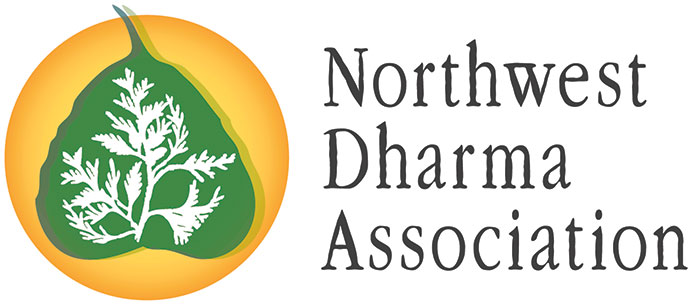Olympia Zen Center to Mark 25 Years of Practice
Written by: Senior students of Olympia Zen Center
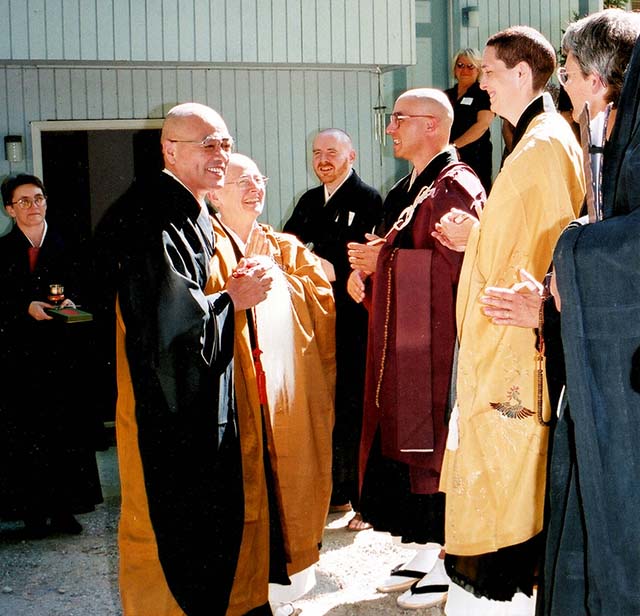
Niho Tetsumei Roshi, who gave dharma transmission to Eidō France Carney in Japan, was among the important Zen leaders at the 2002 dedication of the Olympia Zen Center.
Photos: Courtesy of Olympia Zen Center, Gibsonbradley through Wikimedia Commons.
The Olympia Zen Center sangha will celebrate the 25th anniversary of the founding of the Sōtō Zen temple in July of 2025, as the center continues to evolve for the future.
Many friends, sangha members and special guests will gather in ceremony and deep gratitude for the practice, and for everything the Olympia, Washington, temple has provided. We expect to be honored by the presence of Reverend Gengo Akiba Roshi, the bishop of Sōtō Zen in North America.
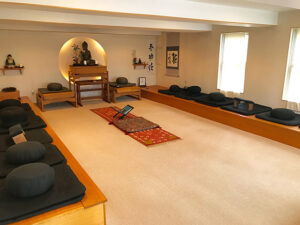
Olympia Zen Center sangha first gathered around founding teacher Rev. Eidō Frances Carney in 1995. This was just after she returned from extensive Zen training in Japan, and from receiving dharma transmission from Niho Tetsumei Roshi, abbot of Entsuji Temple in Tamashima, Japan.
As Eidō Roshi enters her 85th year, her visionary energy continues to bring forth treasures.
Early in 2024 she engaged a renowned sculptor, Simon Kogan, to create a new main altar and Buddha statue for our temple. Eidō san has long wished for a Buddha image that expresses the qualities of Zen practice in our own culture and era.
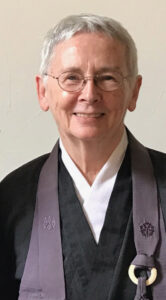
The new Buddha and altar will be installed just before the 25th anniversary events in July, and the public will be welcomed to visit during times we will announce later. One of the events planned for the anniversary celebration is the Sōtō Zen “Eye-Opening Ceremony,” for this new Buddha.
Eidō san, as she is known to her students, introduced Zen practice to interested locals very gradually after her arrival. Once a week they gathered in downtown Olympia at an art gallery, sitting on strips of carpet remnants, using pillows and cushions brought by those who came to practice.
As a group of students settled in around Eidō san, weekly practice moved to the Coach House, adjacent to the Washington State Capitol Museum in Olympia, and then to a rental property just east of downtown.
The daily forms and rituals of Sōtō Zen were introduced step-by-step in the teachings Eidō Roshi offered, and the schedule of practice expanded. New students who expressed an earnest desire to embrace Zen practice were encouraged by Eidō san to choose some community service—for example as a hospice volunteer—because she understood that those practicing a wisdom tradition also need a grounded and active compassion element that extends into the social fabric of a community.
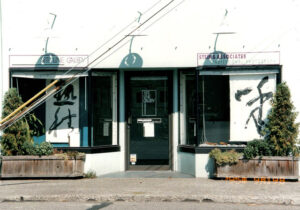
Throughout this time Eidō san’s primary vision was clear: to establish an enduring Sōtō Zen temple for the Olympia region. After a lengthy search by Eidō san and the Olympia Zen Center board of directors, a property with great promise was found. Those who first walked on this land with Eidō san were mesmerized by the majesty of the many cedar, fir and maple trees, as well as by the small lake visible from the property’s building.
That structure was originally built as a duplex to house at-risk youth, and later became a rental duplex. When the sangha found the property, this building was in rough shape.
To transform the building and property into a Zen temple, sangha members were guided by Eidō Roshi’s vision, as well as by skilled sangha members, Thurston County’s code requirements, and the realities of wood, water and stone. During this transformative period the building was remodeled to include a zendo, a founders’ altar, and a dokusan room for private interviews with the teacher. The remodel also included an office and a small shop for books and other practice items, as well as a teacher’s residence and rooms for resident students.
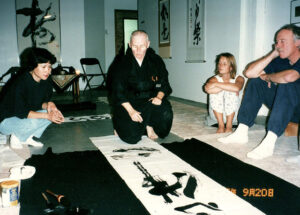
Outside, on this special land, sangha members planted Northwest native species along the wetland buffer, and created the Path of the Ancestors, weaving through the trees and gardens. Each detail was directed by Eidō Roshi, inspired by her aesthetic as an artist, and by her Sōtō Zen training. The atmosphere of years of sincere dharma practice is immediately apparent to all visitors.
In 2002, Zen master Niho Tetsumei Roshi came from Japan to dedicate the temple. Also, a spiritual representative of the Nisqually Tribe offered an Eagle Feather Cleansing Ceremony, the influence of which on the land, is still recognized and deeply felt.
During the dedication the temple names were established, as temples generally have three names. The first is its mountain name: Shin Getsu Zan, which means Heart Moon Mountain. The second is its temple name: Ryōko-an, meaning Good Pond Hermitage. And the third is its public or functional name: Olympia Zen Center.
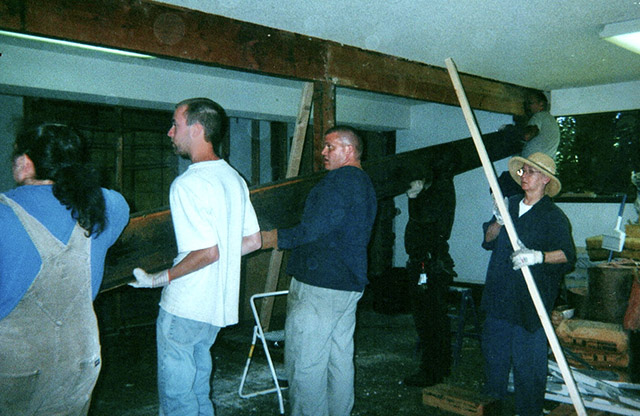
This early moment of creation gave way to a period of deepening practice, and a steady stream of seekers investigating the Zen path. Eidō Roshi supported daily practice at the temple, with newcomers always welcome. Senior practitioners grew in their capacity to embody the subtle rituals and forms handed down through the lineage of teachers. Over 25 years, thousands of people have experienced Sōtō Zen practice at the temple.
As Olympia Zen Center’s 10-year anniversary approached in 2010, Eidō Roshi presented to the board an exciting new vision for the temple grounds—a replica of a legendary hut called Gogo-an. The original Gogo-an is a small hut in which Olympia Zen Center’s revered ancestor, Daigu Ryōkan (1758–1831), lived for many years.
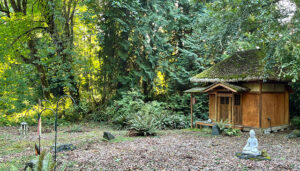
After the death of his own Zen master, Ryōkan had resolved to live as a simple beggar-monk. His highly unusual life, available to us through his poetry and calligraphy, reverberates strongly with Shakyamuni Buddha’s original example of renunciation. Ryōkan retained a close connection with his community throughout his life, and he was a great friend to many. Olympia Zen Center is deeply grateful to have Zen Master Ryōkan as a lineage ancestor.
Building a replica of Gogo-an was no small task, but an amazing local builder named Judy Fleming appeared at the right time. Sangha members had brought back some photos and rough measurements of the original Gogo-an. from a pilgrimage they made to Japan in 2006. Fleming used these scant resources to create the beautiful replica that stands today, as a remarkable reminder of Ryōkan’s life and the center’s dharma lineage.
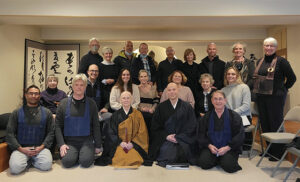
Eidō Roshi also aspired to illuminate the contributions of women Zen teachers. To this end, she and her senior students created Temple Ground Press, a publishing platform highlighting the works of women Zen teachers in the West. Temple Ground has published the writings of dozens of women teachers in a series of books, and has made a significant contribution to all dharma practitioners.
Eidō Roshi, the board of directors, and the sangha continue to maintain Sōtō Zen practice, welcoming newcomers each week, embodying and sharing the forms handed down to us through so many generations. Each time we come together for practice, we renew our Bodhisattva vows to save all sentient beings, to overcome delusion, to tirelessly enter dharma gates, and to follow the Buddha Way.
Photos: Courtesy of Olympia Zen Center, Gibsonbradley through Wikimedia Commons.
Senior students of Olympia Zen Center, who prefer their name not be used.
